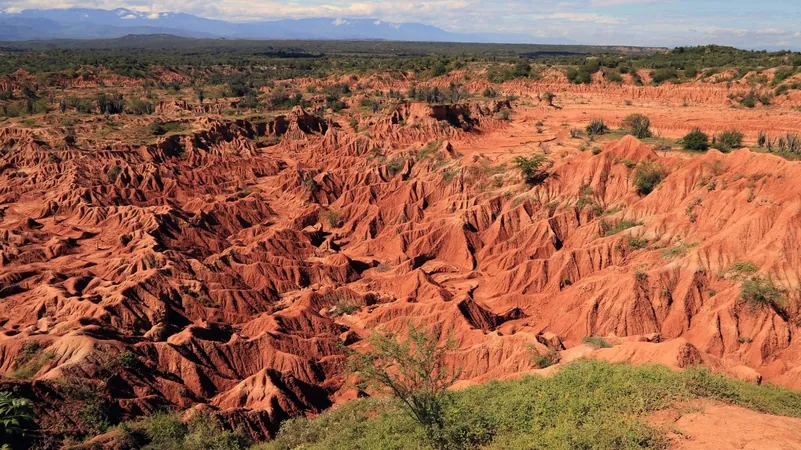
Meet the Colossal 'Terror Bird': The Largest Apex Predator of Its Time!
2024-11-09
Author: Noah
Introduction
Millions of years ago, the vast landscapes of the Americas were ruled by fearsome creatures known as "terror birds." These towering, long-legged predators, equipped with massive beaks, dominated their ecosystems as apex hunters. Recent findings in Colombia have unveiled what could be one of the largest species of these ancient birds ever discovered, intensifying our fascination with this remarkable group of prehistoric fauna.
The Discovery
Paleontologists examining a colossal leg bone unearthed from the La Venta fossil site in Colombia have identified a possible new species of terror bird, believed to have roamed the Earth around 12 million years ago. Standing at an impressive height of over 8 feet (2.5 meters) and weighing approximately 344 pounds (156 kilograms), this giant bird dwarfed many of its South American counterparts. This groundbreaking discovery has been reported in the journal *Papers in Palaeontology*.
Significance of Size
While the majority of known terror bird fossils have been excavated from Argentina—where species typically ranged from 11 to 220 pounds (5-100 kilograms)—the newly identified bird’s remarkable size challenges our previous understanding of these creatures. "They are the only group of birds that achieved the role of terrestrial apex predators, evolving species that conquered South America during the Miocene epoch," stated Federico Javier Degrange, a paleontologist and the study's lead author.
Comparison with Other Species
Notably, the newly identified species stands slightly taller than the Brazilian terror bird Paraphysornis brasiliensis, which reached nearly 8 feet in height but weighed a heftier 397 pounds (180 kilograms). This highlights the incredible diversity and adaptation of terror birds across different environments.
The Journey to Discovery
The story behind this discovery began nearly two decades ago when a curator at the Museo La Tormenta stumbled upon the leg bone in the Tatacoa Desert. Initially, the significance of the find went unrecognized; however, after seeing the bone in 2023, Degrange immediately identified its avian characteristics, confirming its classification as a terror bird.
Ecological Insights
This recent fossil find is particularly significant as it represents the northernmost location for documented terror bird remains in South America, suggesting that these creatures thrived in diverse habitats. "Before this discovery, there was a significant geographical gap between known terror bird locations in Argentina, Brazil, and the United States," Degrange explained. "This implies that some terror bird species might have been adapted to live in tropical environments."
The Miocene Ecosystem
The La Venta ecosystem during the Miocene was lush and vibrant, characterized by vast water bodies, swampy regions, expansive forests, and grasslands. It was a rich hunting ground for the massive terror birds, which likely preyed on large hoofed mammals that were abundant at the time. Other contemporary fauna included relatives of modern armadillos, various bird species, and colossal crocodilians, such as the 30-foot (9-meter) Purussaurus, whose tooth imprints can be seen on the fossilized leg of the terror bird.
Implications for Evolutionary History
This finding not only enhances our understanding of the ecological balance and predator-prey dynamics in Miocene South America, it poses new questions about the evolutionary history of terror birds. Degrange is hopeful that further excavations will unveil more fossils, helping to elucidate why these birds evolved to such massive sizes and what ultimately led to their extinction amid the shifting climatic landscapes of their time.
Conclusion
As scientists continue to probe these ancient mysteries, the story of terror birds remains captivating, painting a picture of a fierce, prehistoric world where these apex predators ruled the land. Who knows what other immense creatures might still be hidden beneath the Earth waiting to be discovered? The search continues!









 Brasil (PT)
Brasil (PT)
 Canada (EN)
Canada (EN)
 Chile (ES)
Chile (ES)
 España (ES)
España (ES)
 France (FR)
France (FR)
 Hong Kong (EN)
Hong Kong (EN)
 Italia (IT)
Italia (IT)
 日本 (JA)
日本 (JA)
 Magyarország (HU)
Magyarország (HU)
 Norge (NO)
Norge (NO)
 Polska (PL)
Polska (PL)
 Schweiz (DE)
Schweiz (DE)
 Singapore (EN)
Singapore (EN)
 Sverige (SV)
Sverige (SV)
 Suomi (FI)
Suomi (FI)
 Türkiye (TR)
Türkiye (TR)